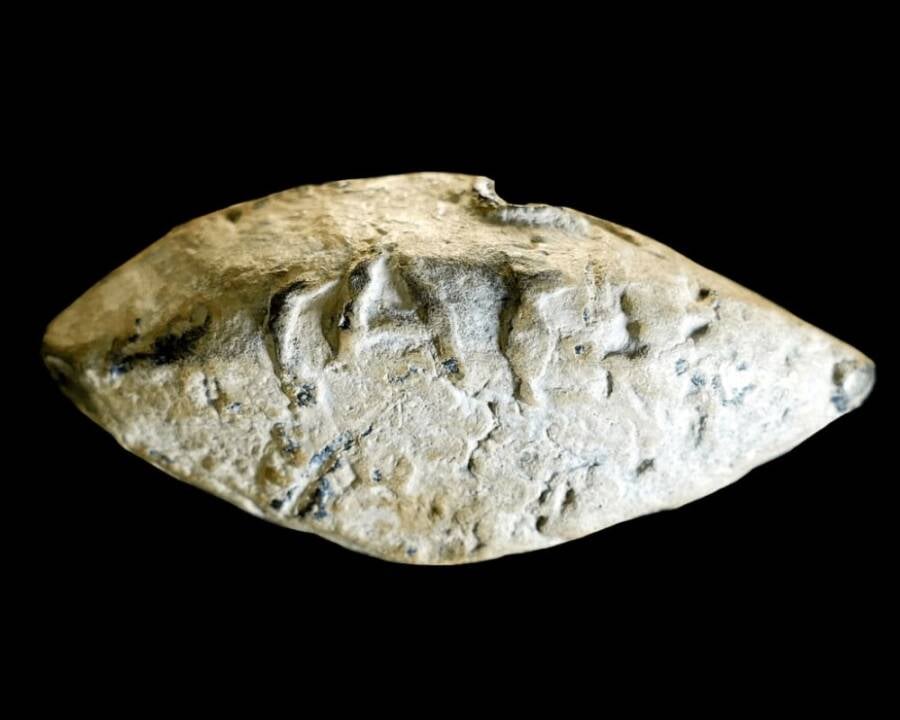The lead bullet's discovery supports the idea that the famous Battle of Munda between Julius Caesar and the sons of Pompey was fought near Montilla, Spain.

University of Salamanca/Zephyrus, XCI, 2023The lead bullet bearing the inscription of Julius Caesar’s name.
In 2019, a farmer in the countryside of Montilla, Andalusia, in southern Spain discovered an ancient lead sling bullet inscribed with the letters “CAES” — an abbreviated form of the name of Gaius Julius Caesar, the great Roman general and statesmen.
The artifact was handed over to researchers from the Autonomous
University of Madrid, the Archaeological Museum of Cabra, and the Museo Histórico of Baena for further study. Their findings were just published in the journal Zephyrus.
In addition to the abbreviated name of Julius Caesar, the lead bullet was also inscribed with the word “IPSCA,” referring to an ancient Ibero-Roman city. It is the first time any Roman Hispania city name has ever been seen on a sling bullet.
The lead bullet is roughly the shape of an almond and measures just under two inches long and half an inch wide.

Per Arkeonews, inscriptions first began to appear on slingshot projectiles in Greece in the fifth century B.C.E., and the practice continued into the time of Roman domination.
Generally, projectiles were inscribed with the name of the maker, the military commander, the legion, or the location of their deployment. In this instance, both inscriptions, “IPSCA” and “CAES,” offer compelling evidence to suggest that an influential historical battle happened in the region.
In 45 B.C.E., Caesar’s forces put an end to the ongoing civil war, culminating in the Battle of Munda, in which Caesar’s army fought a decisive conflict against the sons of Pompey. The actual location of this battle has been hotly debated over the years, but the greater Montilla region has often been suggested.
The discovery of this inscribed lead bullet adds weight to this claim, showing that Caesar’s forces had indeed fought a battle in the area of Montilla — and that Ipsca had allied itself with Caesar’s army against Gnaeus and Sextus Pompeius.
The battle marked a major turning point in Rome’s history, as Gnaeus and Sextus Pompeius represented a potentially major revolution against Caesar’s increasingly widespread rule. At the Battle of Munda, the Pompeians took the high ground, acquiring the upper hand in the conflict that would follow. Caesar, however, managed to lure them down into the midst of the battle.
Caesar himself then joined the skirmish, inspiring his 10th Legion. Meanwhile, Gnaeus attempted to tactically shift troops in order to repel an attack from the Roman cavalry. Unfortunately, this was misread by the other troops, who believed it to be a signal to retreat — causing them to break formation and hand Caesar’s forces a decisive victory, bringing an end to the civil war.

Wikimedia CommonsAn engraving of the Battle of Munda by Matthäus Merian, circa 1625.
It was ultimately a rather dark affair, as neither Caesar nor Pompey had wanted to go to war in the first place. In fact, for many years, Caesar’s daughter, Julia, had been married to Pompey. When she died in 54 B.C.E., however, that link was severed.
In the years that followed, Pompey grew jealous of Caesar and his expanding power. He allied himself with the nobility, who strongly opposed Caesar’s increasingly tyrannical regime, and Pompey and Caesar could no longer see eye to eye. War was the inevitable, if somewhat regrettable, result.
But Pompey was not the only person to have grown uneasy with Caesar’s dictatorial rule. Just one year after Caesar’s victory at Munda on March 17, 45 B.C.E., he was assassinated in the Senate House at Rome on March 15, 44 B.C.E.
This lead bullet bearing Caesar’s name serves as a key piece in the puzzle of Roman history, supporting previously debated and unknown details in Caesar’s long and storied life.
After reading about this lead bullet bearing an inscription of Julius Caesar’s name, learn about the gold coin minted to celebrate Caesar’s assassination that sold at auction for more than $2 million. Or, read about the recently discovered fragments of a Roman chronicle that detail the daily life of emperor Hadrian.





